“Darkest Hour” (2017). Cast: Gary Oldman, Kristin Scott Thomas, Ben Mendelsohn, Stephen Dillane, Samuel West, Lily James, Ronald Pickup. Director: Joe Wright. Screenplay: Anthony McCarten. Web site. Trailer.
Sometimes it takes having our backs against the wall to realize the greatness to which we’re truly capable. Getting there may seem like a dire process, and we may be ready to break down or give it all up if hope appears lost. Such dark night of the soul moments test us to the limit but also show us exactly what we’re made of, a scenario pointedly depicted in the new, fact-based historical drama, “Darkest Hour.”
At the outset of World War II, the British government sought to minimize its involvement and the potential for bloodshed by practicing a policy of appeasement put forth by Prime Minister Neville Chamberlain (Ronald Pickup). By bending to the demands of German Chancellor Adolf Hitler, the U.K. hoped it could curtail the rising tide of warfare. However, when it became apparent the Fűhrer had no intention of honoring his agreements, the need for a new strategy – and a new British P.M. – became all too clear.
But, British politics being what they were at the time, there was also a need to establish a coalition government, one that ultimately was headed by an unlikely leader – Winston Churchill (Gary Oldman), an aging statesman in whom many politicians and even the Crown had little confidence. His track record of past failures haunted him, and many saw him as a buffoon and a catastrophe waiting to happen. Nevertheless, despite these issues, Churchill managed to rise to the top and was asked to form a government by King George VI (Ben Mendelsohn), albeit quite reluctantly.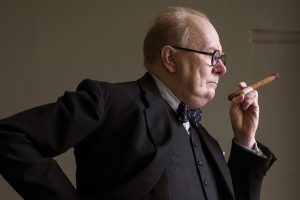 British Prime Minister Winston Churchill (Gary Oldman) assumes the reins of power at one of the most critical junctures in the nation’s history as depicted in the new, fact-based historical drama, “Darkest Hour.” Photo by Jack English, courtesy of Focus Features.[/caption]
British Prime Minister Winston Churchill (Gary Oldman) assumes the reins of power at one of the most critical junctures in the nation’s history as depicted in the new, fact-based historical drama, “Darkest Hour.” Photo by Jack English, courtesy of Focus Features.[/caption]
Once Churchill assumed the reins, he was quickly faced by a severe wartime crisis – the surrounding of British forces by German troops at the French seaport of Dunkirk. With virtually the entire British military in serious peril and the Germans overrunning Europe with no opposition, Churchill faced the collapse of Allied forces and a potential massacre of its own trapped troops. He was thus thrust into devising a plan – any plan – to stave off these twin tragedies.
At the same time, Churchill was being pressured by his own War Cabinet to enter into peace talks with the Germans, to be brokered by Hitler’s Italian allies. This option, advanced by Churchill’s political rivals, most notably Viscount Halifax (Stephen Dillane), would theoretically end the carnage but would essentially turn the U.K. into a fascist lap dog. Conversely, it was believed that rejection of this initiative would ensure British failure in dealing with the crisis on the French coast. And, the more this scenario was allowed to play out, the more Churchill was being railroaded into a position of being labeled a collaborator or an incompetent, either of which would provide grounds for his ouster.
Churchill didn’t always help his own case, either. He was known for his prolific, unabashed imbibing, and he frequently spoke his mind, even when candor wasn’t called for. He even shocked many would-be supporters with his famous (or some would say infamous) “V for Victory” hand gesture, which, in some segments of society, was taken to mean something entirely different (and not especially socially acceptable). However, this unrestrained, freewheeling approach to life also gave him a strong sense of self-confidence, one that would prove to be a saving grace.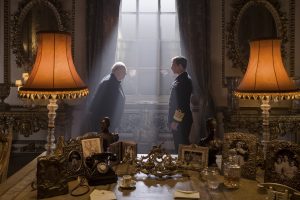 At the request (albeit reluctantly) of King George VI (Ben Mendelsohn, right), British Prime Minister Winston Churchill (Gary Oldman, left) is invited to form a new government at the start of World War II, events outlined in the new historical drama, “Darkest Hour.” Photo by Jack English, courtesy of Focus Features.[/caption]
At the request (albeit reluctantly) of King George VI (Ben Mendelsohn, right), British Prime Minister Winston Churchill (Gary Oldman, left) is invited to form a new government at the start of World War II, events outlined in the new historical drama, “Darkest Hour.” Photo by Jack English, courtesy of Focus Features.[/caption]
No matter what he was up against, Churchill staunchly believed that Britain had to remain firm in its resolve, convinced that the fate of Western civilization was at stake. However, given the pressures he faced, he was also on the verge of cracking. To be sure, he had devoted supporters in his corner, such as his beloved wife Clementine (Kristin Scott Thomas) and loyal secretary Elizabeth Layton (Lily James), but, in seeking solutions to his challenges, he was virtually alone. If he were to survive this crisis, he would have to get creative, both in coming up with plans of action and winning over supporters, which, in each case, would prove to be the people who would come to help him most – the British citizenry.
Churchill’s amazing saga at the start of World War II is a prime example of someone rising to his own greatness, exceeding his potential at a time when the odds were overwhelmingly stacked against him. This inspiring tale shows what we’re each capable of, even in the face of seemingly insurmountable challenges. It shows what it means to surpass everything we thought we could do – and thrive in the process. And that success is largely attributable to the conscious creation process, the means by which we manifest the reality we experience through the power of our thoughts, beliefs and intents.
It’s a pretty safe bet that Churchill probably never heard of conscious creation, yet, based on his actions as depicted in this film, it’s apparent he was quite skillful in wielding it. For instance, to solve the problems he faced, he was forced into getting creative, thinking outside the box, pushing limitations and conceiving plans that had never been tried or perhaps even thought of. This became obvious in his solution for evacuating British troops from Dunkirk when they were penned in by the Germans. Because Britain’s large military rescue ships were unable to land at the French port because of relentless enemy air cover that made them sitting ducks, Churchill had to devise a workable alternative to effect the evacuation. His solution was to put out a call for a citizen armada, a plea to British citizens to deploy their own vessels – fishing boats, pleasure craft, etc. – in a ragtag but concerted effort to bring the boys home. It was a plan no one saw coming – including the Germans – and it had a huge impact on the country’s ability to remain viable in a conflict in which it was increasingly being drawn in. With the support of his loving wife Clementine (Kristin Scott Thomas, left), British Prime Minister Winston Churchill (Gary Oldman, right) assumes the reins of power during a difficult time in the nation’s history in director Joe Wright’s latest offering, “Darkest Hour.” Photo by Jack English, courtesy of Focus Features.[/caption]
With the support of his loving wife Clementine (Kristin Scott Thomas, left), British Prime Minister Winston Churchill (Gary Oldman, right) assumes the reins of power during a difficult time in the nation’s history in director Joe Wright’s latest offering, “Darkest Hour.” Photo by Jack English, courtesy of Focus Features.[/caption]
Such creativity was essential for Churchill to maintain his political stance as well. With the opposition breathing down his neck and with lukewarm support from the Crown, there were many times when the P.M. felt completely alone. To counter these measures, he needed to win over supporters to ensure his continuation in office, namely, the British public and wavering members of Parliament. Through his stunning oratory, impassioned pleas and interaction with the citizenry – acts that he had not previously engaged in or was especially proficient at – he made a case for his beliefs, which subsequently turned into manifested results, particularly when it came to rallying others behind his cause.
To make these plans work, though, Churchill also had to draw upon several key conscious creation principles. For example, he had to overcome any fears or apprehensions he might have had, something that seldom tripped him up but that became progressively more arduous as the pressure on him from multiple fronts continued to mount. He had to be willing to take bold moves, particularly when it came to speaking his mind to his political opponents, the monarchy and the public at large. This took tremendous courage at a time when so many doubted him, but he successfully managed to maintain his resolve, unshakable in his faith in his beliefs and the need to adhere to them – especially with the fate of a nation at stake. Even in the face of opposition from his fellow legislators, British Prime Minister Winston Churchill (Gary Oldman, center) rallies support for his agenda in “Darkest Hour.” Photo by Jack English, courtesy of Focus Features.[/caption]
Even in the face of opposition from his fellow legislators, British Prime Minister Winston Churchill (Gary Oldman, center) rallies support for his agenda in “Darkest Hour.” Photo by Jack English, courtesy of Focus Features.[/caption]
What’s more, Churchill had to realize he was not alone in this crisis, even though it may have felt that way at times. True, he had allies in his corner, such as his wife and secretary, but he needed to curry support from a broader base. And, to do that, he had to ask for that assistance, making a case for his position and recognizing the importance of our inherent connectedness to draw upon the power of co-creation. By doing so, he was able to engender the aid of collaborators to help him materialize the outcomes he sought. It proved to be an effort that a grateful England and Europe would come to appreciate and implement. Had it not transpired that way, we’d likely be facing a world with a very different look today.
Oldman’s stellar portrayal of the legendary leader is handily the greatest strength of this biopic, an effort that has earned him best actor nominations in the Golden Globe, Screen Actors Guild and Critics Choice Award competitions. However, despite the outstanding performance by the protagonist and several of the picture’s supporting players, the overall product is at times a little too talky and drawn out to captivate, given that it’s based on an epic story that truly should engross viewers. With a little too much emphasis on British domestic politics, the film sometimes becomes bogged down and, frankly, a bit boring. Still, despite this shortcoming, “Darkest Hour” has been well-received by critics, as evidenced by the three additional Critics Choice Award nominations that it has captured, including best feature.
Icons deservedly attain the status they achieve as a result of their Herculean efforts. And, based on what’s depicted here, it’s easy to see how Churchill earned such standing. His experience sets an example we can all follow when we find our own backs up against the wall. We just might come away from such experiences finding ourselves rising to our own greatness – and beyond.
Copyright © 2017, by Brent Marchant. All rights reserved.
Friday, December 29, 2017
‘Darkest Hour’ inspires us to rise to our own greatness
Tuesday, December 26, 2017
Check Out Self Discovery Radio
Here’s a little gift just in time for the holidays! Join me and host Sara Troy for the current edition of Self Discovery Radio in which we discuss conscious creation in the movies, particularly as covered in my new book, Third Real: Conscious Creation Goes Back to the Movies. The interview is available as the featured podcast for the next week and will be subsequently archived on the show’s web site. Tune in for some fun and lively movie chat by clicking here.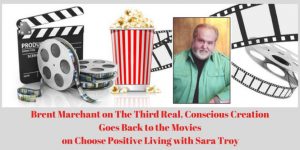
Friday, December 22, 2017
‘The Disaster Artist’ skillfully unmasks hidden truths
“The Disaster Artist” (2017). Cast: James Franco, Dave Franco, Seth Rogen, Ari Graynor, Alison Brie, Jacki Weaver, Paul Scheer, Zac Efron, Josh Hutcherson, June Diane Raphael, Megan Mullally, Sharon Stone, Bob Odenkirk, Melanie Griffith, Bryan Cranston, Jason Mantzoukas, Andrew Santino, Charlyne Yi, Kelly Oxford, Tommy Wiseau, Greg Sestero, Judd Apatow, Kevin Smith, Keegan-Michael Key, Danny McBride, J.J. Abrams, Zach Braff. Director: James Franco. Screenplay: Scott Neustadter and Michael H. Weber. Book: Greg Sestero and Tom Bissell, The Disaster Artist: My Life Inside The Room, the Greatest Bad Movie Ever Made. Web site. Trailer.
Most artists would agree that they seek to garner acclaim by producing quality work, creations applauded for their many noteworthy attributes. But sometimes artists achieve notoriety for their disastrous efforts, works that are so stunningly awful that they earn praise for their utter detestability. In the case of filmmakers, such dismal efforts often lead to their productions becoming cult classics, movies that are loved for how relentlessly bad they are. And one such example provides the basis for the hilariously off-beat new fact-based offering, “The Disaster Artist.”
When aspiring but eminently insecure actor Greg Sestero (Dave Franco) befriends an enigmatic classmate from his San Francisco acting studio, he has no idea what he’s getting himself into. But, as someone seriously in need of bolstering his self-confidence, he’s highly impressed by the inventive though exceedingly unconventional work of fellow actor Tommy Wiseau (James Franco). Although most of Tommy’s performing work defies description and many of his observations consist of cryptic, nonsensical, stream of consciousness statements, Greg nevertheless believes that he can learn something from his eccentric peer. They begin spending a lot of time together – much of it devoted to Greg trying to figure out what Tommy’s often-incoherent ramblings mean – but the impressionable Mr. Sestero seems to get out of it what he wants (at least initially). At the premiere of their film “The Room,” actor Greg Sestero (Dave Franco, left) and director Tommy Wiseau (James Franco, right) have different reactions to the audience response to their offering, as detailed in the off-beat new fact-based comedy, “The Disaster Artist.” Photo by Justina Mintz, courtesy of A24.[/caption]
At the premiere of their film “The Room,” actor Greg Sestero (Dave Franco, left) and director Tommy Wiseau (James Franco, right) have different reactions to the audience response to their offering, as detailed in the off-beat new fact-based comedy, “The Disaster Artist.” Photo by Justina Mintz, courtesy of A24.[/caption]
Surprisingly, despite his pervasive inscrutability, Tommy actually has much to offer, at least in terms of the resources at his disposal. For instance, he appears to sit on a pile of cash, and he has residences in both the Bay Area and Los Angeles. Such circumstances eventually make it possible for Tommy to bankroll a relocation to Hollywood for himself and his new friend, an initiative that they believe will help them step up in their careers. However, despite such optimism, circumstances don’t quite pan out as hoped for. For example, even though Greg lands an agent (Sharon Stone) upon arriving in L.A., he fails to impress casting directors. And, for Tommy, things go even worse, mainly because no one can figure him out.
With their hopes dashed and careers flagging, Tommy comes up with the idea to write his own script for a movie starring Greg, quickly completing the screenplay for a domestic drama titled “The Room.” And, given his considerable finances, he soon hires a cast (Ari Graynor, Jacki Weaver, Zac Efron, Josh Hutcherson, Jason Mantzoukas, Andrew Santino) and crew (Seth Rogen, Paul Scheer, Charlyne Yi, Kelly Oxford) to make the film. With everything in place, the project seems all set to go. But, as quickly becomes apparent, the production is a disaster come to life: the 40-day filming schedule virtually evaporates; many scenes (primarily those involving Tommy) require numerous takes to shoot; most of Tommy’s direction makes little sense, alienating the actors and crew; and some of the director’s creative decisions are of questionable taste.
As the shoot drags on, relations between Greg and Tommy become strained. Tommy resents Greg spending increasingly more time with his new girlfriend, Amber (Alison Brie). He also blocks Greg’s efforts at securing a bona fide acting job on an episode of the sitcom Malcolm in the Middle thanks to a chance meeting with actor Bryan Cranston (playing himself). The once-strong (though admittedly inexplicable) bond gets torn apart. Aspiring actor Greg Sestero (Dave Franco, right) is thrilled, if a bit uncomfortable, at landing the services of an agent (Sharon Stone, left) upon his arrival in L.A. as documented in the off-beat new comedy, “The Disaster Artist.” Photo by Justina Mintz, courtesy of A24.[/caption]
Aspiring actor Greg Sestero (Dave Franco, right) is thrilled, if a bit uncomfortable, at landing the services of an agent (Sharon Stone, left) upon his arrival in L.A. as documented in the off-beat new comedy, “The Disaster Artist.” Photo by Justina Mintz, courtesy of A24.[/caption]
With the production coming to an end, it’s unclear what the future holds. For his part, Greg (like many of the cast and crew members) wants to walk away, hoping that no one ever sees the celluloid debacle. He returns to San Francisco to resume his acting career, achieving moderate success on stage. He seems happy and well-adjusted once again – that is, until he learns of the big premiere Tommy has planned to launch the theatrical release of “The Room.”
Not surprisingly, the reaction to Tommy’s film is anything but what he expects. He’s mortified by the howls of audience laughter echoing throughout the theater. But, little does he realize, he’s on his way to a sleeper hit – even if it’s not the success in the way he envisioned.
As Tommy’s experience illustrates, sometimes life hands us some big surprises. But, even though success may not assume an anticipated form, it’s success nevertheless. The question for us then becomes, can we recognize and appreciate it for what it is, even if unexpected? This is one of those situations where we can view the glass as half full or half empty. What we choose, of course, is up to us, but, no matter which choice we make, we should decide carefully.
This comes down to a question of beliefs, the cornerstone of the conscious creation process, the means by which we manifest the reality we experience. Our belief choices determine the outcomes we realize, and they afford us an infinite range of possibilities for experience at any given moment. The question here, of course, is, will we recognize and understand the true nature of the results when they materialize? Will we appreciate the essence of their being? Or will we misinterpret matters and view them from a skewed perspective (something else fundamentally governed by our beliefs)?
Understanding and appreciating what manifests calls upon us to tap our power of discernment, our capability for recognizing the true nature of what appears before us. This might seem like a fairly straightforward process, but sometimes our view can become clouded by assumptions and various other belief considerations, distorting our analysis of our circumstances. This camouflage can obscure our outlook, leading us to conclusions that aren’t entirely accurate.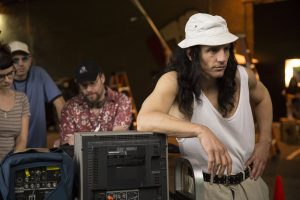 On the set of his film “The Room,” writer-director Tommy Wiseau (James Franco, foreground) often rambles incoherently, confusing his cast and crew, as depicted in director James Franco’s “The Disaster Artist.” Photo by Justina Mintz, courtesy of A24.[/caption]
On the set of his film “The Room,” writer-director Tommy Wiseau (James Franco, foreground) often rambles incoherently, confusing his cast and crew, as depicted in director James Franco’s “The Disaster Artist.” Photo by Justina Mintz, courtesy of A24.[/caption]
In Tommy’s case, for instance, it’s understandable how he might interpret the chorus of chuckles ringing out at his film’s premiere as an insult, especially if he unquestioningly assumed that his project was something to be taken seriously. However, given the laughable nature of the picture, the audience responded in kind, achieving what the film – and, ultimately, its creator – must have had in mind all along, even if not consciously recognized as such. In that regard, Tommy achieved “success” in his endeavor, even if it came in a form he hadn’t necessarily intended.
Conscious creation practitioners sometimes refer to situations like this as examples of semi-conscious creation, where the desired outcome is achieved, even if it’s not perceived as such or takes a form different from what was expected (but nevertheless embodies the sought-after qualities). In working through these instances, we may experience disillusionment or confusion, but these qualities can indeed be overcome, particularly when we employ the aforementioned power of discernment. We can also increase our level of understanding by making greater and more effective use of our intuition, one of the two elements that looms largely in belief formation and assessment.
Tapping into our intuition seldom comes easily for many of us. We tend to tune it out, because it’s seen as less logical, less rational than our intellect, the other chief element used in belief formation and assessment. As a consequence, our intuition is viewed as less reliable, less trustworthy and, hence, easily dismissible. Nevertheless, intuition can often shed significant light on our beliefs and resulting circumstances, helping us grasp what’s really before our eyes.
Again, drawing from Tommy’s example, he initially fails to see his situation for what it is (somewhat unusual for someone who, prior to the film’s premiere, seemed to follow his gut instincts perpetually, no matter how incoherent the resulting actions and observations of his musings may have been). It takes Greg’s astute intuitional observations about what transpires to help Tommy see things for what they are. Were we to follow this lead, we might all find ourselves developing better understandings of the nature of our beliefs, our existence and why matters unfold as they do. And there’s certainly no disaster in that.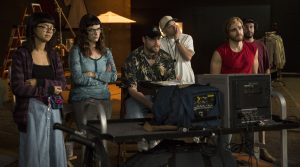 On the set of director Tommy Wiseau’s “The Room,” script supervisor Sandy Schklair (Seth Rogen, center) and actor Greg Sestero (Dave Franco, second from right) cringe whenever the filmmaker makes one of his unpredictable on-screen appearances in the off-beat new comedy, “The Disaster Artist.” Photo by Justina Mintz, courtesy of A24.[/caption]
On the set of director Tommy Wiseau’s “The Room,” script supervisor Sandy Schklair (Seth Rogen, center) and actor Greg Sestero (Dave Franco, second from right) cringe whenever the filmmaker makes one of his unpredictable on-screen appearances in the off-beat new comedy, “The Disaster Artist.” Photo by Justina Mintz, courtesy of A24.[/caption]
Despite a half-baked teaser trailer that makes this project look like an inside joke drummed up by frat boys between bong hits, this quirky fact-based comedy is surprisingly entertaining, if a bit dragged out in spots. A more fully fleshed out back story probably would have helped, too, but then that may have also undermined the portrait of inscrutability being painted about the story’s protagonist. Nonetheless, the film delivers surprisingly well in the performance department, with fine turns by the Franco brothers and an array of colorful supporting cast members, punctuated by the tongue-in-cheek observations of Hollywood heavyweights like J.J. Abrams, Kevin Smith, Keegan Michael Key, Danny McBride and Kristen Bell. All in all, “The Disaster Artist” is a delightfully pleasant surprise that, upon first glance, would seem to have little to offer.
Actor-director James Franco’s latest is garnering considerable praise in awards competitions, having been named one of the National Board of Review’s Top 10 Films and capturing the organization’s award for best adapted screenplay. In addition, the release earned two Golden Globe Award nominations for best comedy picture and best comedy actor, Screen Actors Guild and Independent Spirit Award nods for best lead actor, and four Critics Choice Award nominations, including best comedy, actor and adapted screenplay. Expect the accolades to continue throughout awards season.
Being misunderstood may cause us considerable consternation. But misinterpretations of our intents just might pay unexpected dividends as well. We may be frustrated at what transpires, but we could also find ourselves laughing all the way to the bank. If you doubt that, just ask Tommy Wiseau.
Copyright © 2017, by Brent Marchant. All rights reserved.
Wednesday, December 20, 2017
‘The Last Jedi’ tackles life’s lessons, striking a balance and finding our way
“Star Wars: The Last Jedi” (2017). Cast: Mark Hamill, Carrie Fisher, Adam Driver, Daisy Ridley, John Boyega, Oscar Isaac, Andy Serkis, Domhnall Gleeson, Laura Dern, Benicio del Toro, Lupita Nyong’o, Gwendoline Christie, Kelly Marie Tran, Frank Oz (voice), Anthony Daniels, Joonas Suotama, Jimmy Vee, Justin Theroux, Tim Rose, Tom Kane (voice). Director: Rian Johnson. Screenplay; Rian Johnson. Source Material: George Lucas, “Star Wars.” Web site. Trailer.
Finding our place in the world.
Tapping into our source of personal power.
Learning how to balance strength and vulnerability, power and temperance, and when to charge and when to retreat.
All of the foregoing are noble pursuits aimed at helping is get through life and its challenges, be it in both everyday matters and in more heroic ventures. And understanding what it means to be a master of these skills is a venture that defines us and guides us in how we conduct our lives. Those are among some of life’s big questions tackled in the latest installment of one of filmdom’s most storied franchises, “Star Wars: The Last Jedi.”
Picking up where the seventh offering in this series left off, “The Last Jedi” follows the continuing exploits in this epic galactic drama, bringing viewers up to date on the adventures of characters from past episodes and introducing new players into the mix. The narrative consists of several story threads that run parallel with one another and eventually become intertwined for a blockbuster climax.
Given the foregoing, the picture’s plot is somewhat complicated, to say the least, and detailing it would probably reveal too much. In a nutshell, however, the film follows the efforts of a ragtag group of rebel forces led by General Leia Organa (Carrie Fisher) waging war with the First Order, an oppressive dictatorship brutally ruled by Supreme Leader Snoke (Andy Serkis) and his chief protégé, Kylo Ren (Adam Driver), a ruthless villain who, ironically, is more than occasionally morally conflicted about carrying out his charge. As this battle plays out, one of the rebels’ chief warriors, Rey (Daisy Ridley), journeys to a remote planet to find an aging enigmatic peer, Luke Skywalker (Mark Hamill), to learn the ways of the Jedi, a mystical corps of heroic combatants, in hopes that his teachings will help her and others in their conflict with the First Order. In addition, two other rebel fighters, Finn (John Boyega) and Rose (Kelly Marie Tran), backed by comrade Poe Dameron (Oscar Isaac), go in search of a scurrilous code breaker (Benicio del Toro) to help them devise a plan for undermining First Order detection technology.
The missions of the characters in these respective scenarios bring them up against the issues raised above. How they respond depends on who they are as individuals and how they comport themselves when brought face to face with the Force, a potent, intangible wellspring of power that binds all things and connects everyone in the Universe. The Force is theirs to wield, but what they do with it ultimately hinges on their intents and how they approach handling it. Each character is thus left to determine his or her own destiny, a profound introspective process that prompts each individual to examine what he or she hopes to achieve and how to go about doing so, a significant, soul-searching exercise for all concerned. Jedi Master Luke Skywalker (Mark Hamill) wrestles with whether or not to continue his mission in “Star Wars: The Last Jedi,” the eighth installment in this storied movie franchise. Photo courtesy of Lucasfilm Ltd.[/caption]
Jedi Master Luke Skywalker (Mark Hamill) wrestles with whether or not to continue his mission in “Star Wars: The Last Jedi,” the eighth installment in this storied movie franchise. Photo courtesy of Lucasfilm Ltd.[/caption]
In many regards, this installment in the franchise thus echoes many of the themes first raised in “Star Wars Episode V: The Empire Strikes Back” (1980), in which a young Skywalker is initiated into the ways of the Jedi for himself under the tutelage of supreme mentor, Master Yoda (Frank Oz). In many ways, this film brings that story full circle, particularly where Luke is concerned, who now serves as the master instructing a new generation of would-be followers. It gives the legendary warrior an opportunity to assess what he would like to do going forward, in large part based on what he had done in the past, a track record marked by mixed outcomes that give him pause, particularly where questions of responsibility and intent are concerned. Others struggle with comparable conundrums of their own as well, and their approaches to addressing them mimic those of the Jedi leader, who must now decide whether he wants to rejoin a flight in which he’s unclear about what his role might be.
As the various story lines play out, it becomes apparent that the characters’ struggles with understanding and employing the Force run parallel to what many of us experience as we seek to become masters of the conscious creation process, the philosophy that maintains we manifest our reality through the power of our thoughts, beliefs and intents. They come to see that the Force, like conscious creation, is neither inherently good nor bad; it all depends on what we do with it, and that comes down to the implementing beliefs we employ in activating the process. The intents we choose to embrace shape what springs forth from them from the realm of intangible potential and into the materialized world of physicality.
Of course, given the power involved, as well as the potential potency of the resulting consequences, conscious creation and management of the Force both call upon us to recognize the responsibility that comes with such practices. It implores us to choose our beliefs carefully, for errant moves can easily lead to disaster, outcomes that can leave our heads spinning, even with seemingly the best of underlying intentions. As one of the chief warriors in a contingent of rebel forces, Rey (Daisy Ridley) seeks to learn the ways of the Jedi in director Rian Johnson’s “Star Wars: The Last Jedi.” Photo courtesy of Lucasfilm Ltd.[/caption]
As one of the chief warriors in a contingent of rebel forces, Rey (Daisy Ridley) seeks to learn the ways of the Jedi in director Rian Johnson’s “Star Wars: The Last Jedi.” Photo courtesy of Lucasfilm Ltd.[/caption]
At the same time, we must also be careful not to let prudence become a hindrance. Proceeding cautiously might well be warranted, but, if allowed to hold sway, it could also hold us back significantly. Overly timid behavior in our belief choices can paralyze us, keeping us from pursuing opportunities that could well prove highly valuable. But, by failing to follow up on them, we’ll never know what they’ll yield.
Striking a balance where these principles are concerned is the chief challenge that all conscious creation initiates must address, and there are no easy or absolute answers. What’s more, as readily becomes apparent, things are not all black or white, and sometimes even the unlikeliest of outcomes, like failures, can prove to be the greatest teachers. The experiences of Luke, Rey, Finn, Rose, Poe, Kylo Ren and others all fall squarely in line with these considerations, and their odysseys provide us with examples to assess and consider for ourselves. The inspiration and enlightenment of these scenarios could be quite useful in our own endeavors, and we should give them serious thought as we proceed.
These insights help to set “The Last Jedi” apart from most of its predecessors. There’s an intriguing ambiguity that flows through the narrative of this installment, making things a little less certain at times, something that diehard fans of the franchise may well find a little unnerving. However, given the intrinsic nature of the Force – or of the principles of conscious creation – this film’s underlying metaphysical message is thus also more fundamentally realistic, accurately reflecting the notion that we always have access to limitless (if not always clearly defined) possibilities and are not saddled with a more identifiable (yet inherently smaller) set of options for existence. The onus for what manifests is thus placed on the shoulders of their creators (just as it is with the rest of us in our own everyday lives), and that’s a concept some of us (including diehard “Star Wars” fans) may find somewhat unsettling.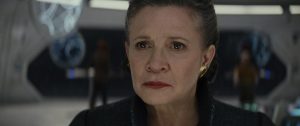 General Leia Organa (Carrie Fisher in one of her last screen roles) leads a group of rebel forces against the authoritarian First Order in “Star Wars: The Last Jedi.” Photo courtesy of Lucasfilm Ltd.[/caption]
General Leia Organa (Carrie Fisher in one of her last screen roles) leads a group of rebel forces against the authoritarian First Order in “Star Wars: The Last Jedi.” Photo courtesy of Lucasfilm Ltd.[/caption]
This outlook doesn’t jibe with the restricted range of pat scenarios that many believe are the only ones open to storytellers or to us in our respective creative undertakings. However, embracing a view of existence based on such innate limitation takes away much of the wonder that accompanies the process of creative discovery that conscious creation (or the Force) makes possible. For my money, I’d rather live with this more expanded view of things, and that’s one of the reasons why I liked this movie so much: It celebrates a view of existence that gives us more choices and holds the potential for far greater fulfillment than what a more curtailed view can possibly offer.
This latest installment of this storied franchise represents a vast improvement over the last two offerings in this series, providing some much-needed relief to a mythology that had been rapidly running out of gas and originality. With a well-crafted, insightful allegorical story line, fine performances by Hamill and Fisher (in one of her last screen appearances), excellent special effects, and a restrained reliance on action sequences to carry the narrative, “The Last Jedi” gives viewers much to ponder while serving up an eminently entertaining saga. Admittedly it’s not perfect – a little overlong (especially in the pacing in the first 45 minutes), a little weak in its use of 3D effects and a tad too cutesy in its comic relief – but these shortcomings don’t significantly detract from the overall product. It’s truly satisfying to see things finally getting back on track.
What it means to create our destiny is a common theme in many films, especially those with heroic narratives like this. And, thankfully, this film provides viewers with much to think about, especially when it comes to discerning our role and realizing that matters aren’t always as clear cut or simplistic as we might like to think they are. It’s an ongoing process in which we engage in ways both great and small. But, no matter what endeavor we’re tasked with undertaking, let us always hope that, as we do so, the Force is always with us.
Copyright © 2017, by Brent Marchant. All rights reserved.
Join Me for The Cinema Scribe
Tune in for the latest Cinema Scribe segment on Bring Me 2 Life Radio, Wednesday, December 20, at 12:45 pm ET, by clicking here. And, if you don't hear it live, catch it later on the podcast!
Tuesday, December 19, 2017
This Week in Movies with Meaning





Tuesday, December 12, 2017
‘The Shape of Water’ floats new possibilities for consideration
“The Shape of Water” (2017). Cast: Sally Hawkins, Michael Shannon, Octavia Spencer, Richard Jenkins, Michael Stuhlbarg, Doug Jones, Nick Searcy, Stewart Arnott, Nigel Bennett, Lauren Lee Smith, Martin Roach, Allegra Fulton, John Kapelos, Morgan Kelly, Marvin Kaye, Wendy Lyon. Web site. Trailer.
We all think we know what it means to fall in love, but do we really? Sometimes the reality differs markedly from what we expect, perhaps taking us in some highly unconventional directions. But, when we find that true love, no matter what form it takes, we’re generally willing to do whatever it takes to nurture and protect it, regardless of what we’re up against. Such is the case of an unlikely duo in the whimsical new fantasy/fairy tale, “The Shape of Water.”
As a custodial worker in a secret government marine laboratory in Baltimore in 1962, Elisa Esposito (Sally Hawkins) quietly goes about her job, performing her everyday chores and trading quips with her colorful, sassy co-worker, Zelda (Octavia Spencer). The banter tends to be somewhat one-sided, though, given that Elisa is mute, but she nonetheless never seems to have any trouble making her feelings known, especially when it comes to dealings with the facility’s intimidating new security chief, Richard Strickland (Michael Shannon).
Despite the relative calm that has long prevailed at the lab, things change dramatically with the arrival of a mysterious new specimen, an amphibian being that looks like a cross between a man and a reptile (Doug Jones). Having been taken from its home in the Amazon, the creature has been brought to the facility for further study under the auspices of scientist Dr. Robert Hostetler (Michael Stuhlbarg). But the new arrival is more than just a scientific curiosity; it’s believed that the aquatic enigma may possess special abilities, some that might even be weaponized (hence the beefed-up security). These potentially significant, highly coveted qualities are much sought after by American military officials, especially now that the country is caught up in the Cold War with the Soviet Union, a threat that’s perceived as lurking everywhere – even in the lab.
When Elisa and Zelda are assigned to work in the area where the creature is housed, they get quite an astonishing eyeful. Not only do they catch a glimpse of the strange new being, but they also witness the unduly cruel treatment to which it’s summarily subjected, behavior that elicits a comparably brutal response from the creature. Elisa is appalled at what she sees and instantly takes pity on the wounded victim. So, when no one is around, she quietly sneaks into the lab to show the new visitor that there’s more to being human than inflicting harm on others. By exhibiting kindness and compassion, she conveys a very different impression of humanity, and the creature responds in kind. An unusual bond is forged, one that grows into an unconventional friendship – and more. Intimidating security chief Richard Strickland (Michael Shannon, left) questions custodial workers Elisa Esposito (Sally Hawkins, center) and Zelda Fuller (Octavia Spencer, right) about their work routine in a secret government marine lab in director Guillermo del Toro’s new romantic fantasy, “The Shape of Water.” Photo courtesy by Kerry Hayes, of Fox Searchlight Pictures.
Intimidating security chief Richard Strickland (Michael Shannon, left) questions custodial workers Elisa Esposito (Sally Hawkins, center) and Zelda Fuller (Octavia Spencer, right) about their work routine in a secret government marine lab in director Guillermo del Toro’s new romantic fantasy, “The Shape of Water.” Photo courtesy by Kerry Hayes, of Fox Searchlight Pictures.
However, with various factions vying for control of “the asset,” as the creature is often called, its fate is soon up for grabs. And so, with such perilous uncertainty looming, Elisa decides to take action to protect her new friend. With the aid of her somewhat neurotic neighbor, Giles (Richard Jenkins), and a few unexpected allies, Elisa undertakes a risky plan to shepherd the defenseless being out of harm’s way, an initiative that holds the promise to pay more dividends than she ever could have imagined. But will her efforts pan out?
The unusual relationship that develops between Elisa and her Amazonian companion may defy convention, but who’s to say that such an arrangement can’t work, that it’s inherently outside the realm of possibility? Those who push past traditional barriers and challenge the prevailing wisdom might find that the uncharted territory that such involvements occupy is richly rewarding, even if it’s something others would never consider. After all, when the heart is involved, there’s no telling what might arise, and the outcome may prove to be quite revelatory, both in terms of what works for us – and the lengths we’ll go to in protecting it.
Of course, such connections are possible only if properly supported by beliefs that make them happen, a cornerstone principle of the conscious creation process, the philosophy that maintains we manifest the reality we experience through the power of our thoughts, beliefs and intents. And, in the case of Elisa and her unlikely consort, those metaphysical building blocks are obviously in place to make their bond possible.
In forging this relationship, however, the participants obviously must push past conventional limitations and beliefs that would otherwise hold them back. But they apparently understand this and are unconcerned about the potential influence of any impediments that might impinge upon their success. That’s one of conscious creation’s chief aims – one we’d be wise to aspire to – and Elisa and her beau set an inspiring example to follow.
However, if Ms. Esposito and her companion are so taken with the idea of making their association work, one might wonder why they’ve also created so much ancillary strife in their lives. Why burden themselves with such seemingly unnecessary complications? When a defenseless laboratory creature is threatened, custodial worker Elisa Esposito (Sally Hawkins, right), along with her neighbor, Giles (Richard Jenkins, left), concocts a plan to protect it in the inventive new fantasy/fairy tale, “The Shape of Water.” Photo by Kerry Hayes, courtesy of Fox Searchlight Pictures.
When a defenseless laboratory creature is threatened, custodial worker Elisa Esposito (Sally Hawkins, right), along with her neighbor, Giles (Richard Jenkins, left), concocts a plan to protect it in the inventive new fantasy/fairy tale, “The Shape of Water.” Photo by Kerry Hayes, courtesy of Fox Searchlight Pictures.
Despite the hardships posed by such challenges, conundrums like those they experience can also serve as a galvanizing force. By putting their bond to the test, the would-be lovers provide themselves an opportunity to determine the viability of their connection, to see if it can withstand the pressures put upon them that could tear them apart. Under circumstances like these, aspiring mates can evaluate just how committed they are to one another and to their proposed undertaking. Such an exercise can be quite revelatory, exposing weaknesses and spotlighting strengths that could potentially remain hidden but that might ultimately prove invaluable to the success of the venture.
These are principles that are transferable to virtually any type of conscious creation initiative, whether undertaken individually or in tandem. They’re equally applicable in creative pursuits, business ventures, vocational undertakings or conceivably any other course of conduct we consider engaging in. This, in turn, opens up an array of new possibilities, many of which may not otherwise garner any consideration or attention. But then that’s what the miracle of conscious creation makes possible.
Though at times a little predictable, “The Shape of Water” delivers the goods on so many fronts. Director Guillermo del Toro’s fantasy romance serves up an utterly charming tale with superb special effects, gentle humor, heartwarming sincerity, and a host of excellent performances, especially by Hawkins, Spencer and Jenkins. Think “Beauty and the Beast” (1991, 2017) meets “E.T. the Extra-Terrestrial” (1982), and you’ve got a good idea what’s going on here. It’s truly satisfying to see a film that genuinely lives up to its pre-release hype.
“The Shape of Water” is also a celebration of the underdog. The most likable – and happiest – characters in the film are those who live their lives outside the mainstream, including characters who are disabled, gay, minorities and even alternate species, all of whom experience ridicule, criticism, harm and ostracism just for being different (and to a much harsher degree than they would typically experience today). This theme is also reflected through upbeat TV and movie clips featuring such famous nonconformists as Carmen Miranda, Mr. Bojangles, Maynard G. Krebs and Mr. Ed. These characters all relish their individuality – and very much in stark contrast to those in the mainstream majority, whose snarly attitudes toward those who are different reveal their inherent insecurities and how threatened they feel by those who aren’t afraid to shed conventional limitations and celebrate their uniqueness.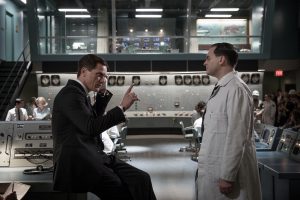 Intimidating security chief Richard Strickland (Michael Shannon, left) often finds himself at odds with marine scientist Dr. Robert Hofstetler (Michael Stuhlbarg, right) in “The Shape of Water.” Photo by Kerry Hayes, courtesy of Fox Searchlight Pictures.
Intimidating security chief Richard Strickland (Michael Shannon, left) often finds himself at odds with marine scientist Dr. Robert Hofstetler (Michael Stuhlbarg, right) in “The Shape of Water.” Photo by Kerry Hayes, courtesy of Fox Searchlight Pictures.
The film is attracting considerable awards season buzz, having snagged 14 Critics Choice Award nominations, including best picture, actress (Hawkins), supporting actor (Jenkins), supporting actress (Spencer), director and screenplay, along with an array of technical awards. In addition, the picture earned seven Golden Globe Award nods, including best dramatic picture, dramatic actress (Hawkins), supporting actor (Jenkins), supporting actress (Spencer), director and screenplay. It was also named one of the American Film Institute’s Top 10 films of the year. With a response like this, other accolades are sure to follow.
Even when we believe we know what love is, we can’t really know until we find ourselves wrapped up in it, ensconced in the rapture of emotion that washes over and thoroughly envelops us. It’s an undeniable feeling, one that we never want to let go of, even when that seems destined to occur. But, when faced with such circumstances, something just might come along to sustain it, making it possible to truly live happily ever after.
Copyright © 2017, by Brent Marchant. All rights reserved.
‘Christmas’ release tells a Dickens of a tale
“The Man Who Invented Christmas” (2017). Cast: Dan Stevens, Christopher Plummer, Jonathan Pryce, Simon Callow, Miriam Margolyes, Morfydd Clark, Justin Edwards, Miles Jupp, Donald Sumpter, Ely Sloan, Anna Murphy, Ian McNeice, Bill Paterson, Ger Ryan. Director: Bharat Nalluri. Screenplay: Susan Coyne. Book: Les Standiford, The Man Who Invented Christmas. Web site. Trailer.
It’s been said that helping others is the best way to help ourselves. We get back what we put out, and, if that turns out to be goodwill and generosity of spirit, then that’s what will return our way. So it was for a world-class author seeking to get his life and career back on track after a creative slump, as demonstrated in the heartwarming new holiday offering, “The Man Who Invented Christmas.”
Two years following the resounding success of his novel Oliver Twist, author Charles Dickens (Dan Stevens) was experiencing a dry spell, having produced three literary failures in a row. With his personal financial situation growing increasingly perilous, he desperately needed to get his career back on track. However, that was easier said than done, given that he was also suffering from a severe case of writer’s block. And, with his publisher breathing down his neck, the situation was growing ever more dire. What to do?
Just when all began to seem lost, however, Dickens came up with an idea for a new work – a Christmas novel with an uplifting message, tinged with elements of spirituality and the supernatural. His publisher was skeptical, unsure about the market for a holiday themed book. What’s more, given that it was already October, the chances of getting the book written, illustrated, printed and marketed in time for the big day seemed highly unlikely. But Dickens was confident that he could pull it off, and, when his publisher raised ever more skepticism, the author decided to go it alone (and who said self-publishing was a recent phenomenon?). In an attempt to overcome a severe case of writer’s block, author Charles Dickens (Dan Stevens, foreground) consults with an apparition of the protagonist of his emerging new work, Ebenezer Scrooge (Christopher Plummer, background), in “The Man Who Invented Christmas.” Photo by Kerry Brown, courtesy of Bleecker Street Media.
In an attempt to overcome a severe case of writer’s block, author Charles Dickens (Dan Stevens, foreground) consults with an apparition of the protagonist of his emerging new work, Ebenezer Scrooge (Christopher Plummer, background), in “The Man Who Invented Christmas.” Photo by Kerry Brown, courtesy of Bleecker Street Media.
Drawing upon an array of influences from his everyday life to memories from his past and, perhaps most importantly, his dreams and vivid imagination, Dickens gradually began to piece together his new work. The book would tell the story of a bitter, miserly old business man named Ebenezer Scrooge who would come to learn the meaning of Christmas by changing his ways and becoming eminently charitable when confronted by ghosts from his past, present and future. The writing particularly took off when Dickens began creatively interacting with an apparition of his book’s protagonist (Christopher Plummer), gaining insights into the character and how his story should play out. It was a collaboration that would eventually lead to the publication of one of Dickens’s most beloved and best-selling works, A Christmas Carol.
Dickens’s success in bringing his work to life – especially in such short order – and its remarkable sales performance – both at the time of the book’s release and ever since – shouldn’t come as any surprise, though, given that it was a reflection of the author and his beliefs. And those beliefs, as practitioners of the conscious creation process are well aware, provide the basis for manifesting the reality we experience, which was very much the case here.
To be sure, it’s highly unlikely that Dickens ever heard of conscious creation, yet his actions clearly reflect the philosophy’s principles, which are apparent in the resulting outcomes. For instance, Dickens strongly believed in philanthropy and magnanimity toward one’s fellow man, being charitable toward those less fortunate. This was an idea espoused in a number of his previous writings, drawing attention to the plight of the less fortunate at a time when such matters weren’t as easily publicized as they are today. Paying attention to influences from his dreams helps author Charles Dickens (Dan Stevens, left) with inspiration for his latest work, especially when guided by an apparition of his book’s protagonist, Ebenezer Scrooge (Christopher Plummer, right), in the new holiday release, “The Man Who Invented Christmas.” Photo by Kerry Brown, courtesy of Bleecker Street Media.
Paying attention to influences from his dreams helps author Charles Dickens (Dan Stevens, left) with inspiration for his latest work, especially when guided by an apparition of his book’s protagonist, Ebenezer Scrooge (Christopher Plummer, right), in the new holiday release, “The Man Who Invented Christmas.” Photo by Kerry Brown, courtesy of Bleecker Street Media.
What’s more, Dickens personally acted upon these notions, readily providing financial support to those in need, such as his father, John (Jonathan Pryce), for whom Charles purchased a home in the country in which his fiscally irresponsible dad and mother (Ger Ryan) could live. He thus set a personal example for others to follow (especially those who had the most to offer but who also may have been the most reluctant to give of themselves), demonstrating the value of such charitable acts, gestures that ultimately benefitted both the recipients of such generosity as well as to those who bestowed it upon them.
Given these beliefs and the results that flowed from them, then, it’s easy to see how Dickens could write about them so easily and passionately, both in his previous books and, especially, in the work that’s the subject of this film. He thus used his writing and his actions to make the case for a lesson that everyone could learn from, a message that’s just as relevant now as it was in 19th Century England.
Watching the writing process unfold – both in terms of crafting the story and preparing the finished book for public sale – reveals Dickens’s impressive ability to draw upon all of his creative resources to bring his project to life, again, accomplishments attributable to his beliefs. Even in the wake of his literary failures, for example, Dickens knew he could get back on track, especially when faced with a short window to produce his proposed new work. His fervent belief in his ability to marshal all of the necessary resources made it happen, an excellent illustration of how we can bring forth our conceptions from the realm of the intangible into physical existence. Surrounded by characters from his new work, particularly protagonist Ebenezer Scrooge (Christopher Plummer, with top hat at center left), author Charles Dickens (Dan Stevens, center right) gazes upon a bookstore window announcing the title’s upcoming release in the new holiday offering, “The Man Who Invented Christmas.” Photo by Kerry Brown, courtesy of Bleecker Street Media.
Surrounded by characters from his new work, particularly protagonist Ebenezer Scrooge (Christopher Plummer, with top hat at center left), author Charles Dickens (Dan Stevens, center right) gazes upon a bookstore window announcing the title’s upcoming release in the new holiday offering, “The Man Who Invented Christmas.” Photo by Kerry Brown, courtesy of Bleecker Street Media.
Considering the sources of Dickens’s inspiration, it’s also apparent that he knew how to pay attention to synchronicities, those seemingly perfectly tailored “coincidences” that help to point the way toward our destiny. By drawing from the experiences of his youth and listening to the captivating ghost tales told to his children by a young Irish immigrant housekeeper (Anna Murphy), for instance, Dickens picked up on the significance of these elements and the role they would come to play in the narrative of A Christmas Carol. His awareness of these influences thus fueled and reinforced the beliefs that drove the creative process that brought his finished work into being.
Paying attention to synchronicities is important, because it helps bolster our intuitive abilities, one of the chief contributing factors in belief formation. This aspect of the belief formation is often woefully underutilized, mainly because it’s seen as less trustworthy than our intellect, the other driver of the process, which is generally viewed as more rational and, consequently, more reliable. However, just because our intuition is considered less logical doesn’t mean that it’s any less useful; in fact, as Dickens’s example alone shows, it’s positively essential to achieving our sought-after success. Indeed, think of all those who would not have benefitted from the uplifting message of A Christmas Carol if Dickens had not drawn upon his intuition in bringing his work to life.
In presenting the back story of this holiday classic, “The Man Who Invented Christmas” offers viewers a modestly entertaining look at how this work came into being. The film features fine performances by Stevens and, especially, Plummer, with both bringing their characters to life with convincing credibility and a great deal of wit. However, given the enduring charm of the book on which this film is based, truthfully I was expecting something a bit more “magical” out of this release, which, regrettably, comes across as surprisingly flat, with only periodic smatterings of wonder. To its credit, the picture does an excellent job of showing how we can draw inspiration from our surroundings and experience to produce amazing works of creativity, and it effectively reinforces the message of benevolence of A Christmas Carol. But, overall, the film is somewhat more pedestrian than whimsically serendipitous, which I found a little disappointing. In short, as holiday movies go, this one isn’t bad; it’s just not great. Surrounded by his parents (Jonathan Pryce, Ger Ryan, left and second from left) and wife (Morfydd Clark, right), author Charles Dickens (Dan Stevens, second from right) celebrates the release of his new work, A Christmas Carol, in “The Man Who Invented Christmas.” Photo by Kerry Brown, courtesy of Bleecker Street Media.
Surrounded by his parents (Jonathan Pryce, Ger Ryan, left and second from left) and wife (Morfydd Clark, right), author Charles Dickens (Dan Stevens, second from right) celebrates the release of his new work, A Christmas Carol, in “The Man Who Invented Christmas.” Photo by Kerry Brown, courtesy of Bleecker Street Media.
Nevertheless, despite the picture’s shortcomings, it still conveys the message of goodness that Dickens sought to express through his life and work. And, given the state of the world these days, that’s something all of us can probably never be reminded of enough.
Copyright © 2017, by Brent Marchant. All rights reserved.
Monday, December 11, 2017
This Week in Movies with Meaning


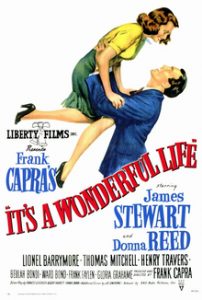
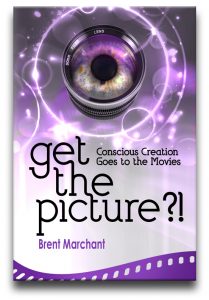

Tuesday, December 5, 2017
Tune in for The Cinema Scribe

Monday, December 4, 2017
This Week in Movies with Meaning
Reviews of "Three Billboards Outside Ebbing, Missouri" and "The Man Who Invented Christmas," as well as free book excerpts and social media news, are all in the latest Movies with Meaning post on the web site of The Good Radio Network, available by clicking here.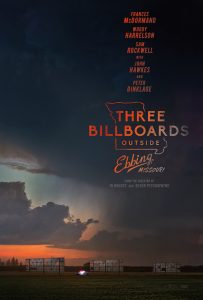

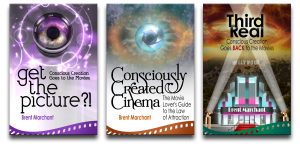


Join Me on Ello!
I’m pleased to announce that I’ve now launched a profile on the social media site Ello, the network for artists, creators and their fans. Look for my posts, and enjoy the material submitted by my fellow writers, artists and creatives. To visit my profile, click here.
